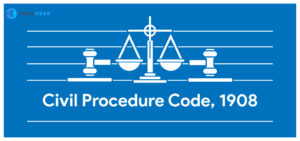Civil Procedure Code,1908 – Overview of the Bare Act
What is the Civil Procedure Code?
The Civil Procedure Code, 1908 is a procedural law governing the administration of civil proceedings in India.
The Act has two parts –
a) The first part has a total of 158 Sections. The sections comprise of general provisions of jurisdiction.
b) The second part contains the first schedule comprising of 51 Orders and Rules. The Orders and the Rules prescribe the procedure and method that governs civil proceedings in the country.
The Bare Act Classification
As mentioned above, the Civil Procedure Code, 1908 has 158 sections divided into 11 parts. Here are the 11 parts of the Act –
- Part 1 – Suits in General – from section 9 to section 35.
Sections 9 – 35B and Orders 1-20 of the First Schedule contains provisions regarding suits. Section 9 states that a civil court has the jurisdiction to try civil suits of civil nature whereas section 10 deals with “stay of the suit.” Section 11 talks about the provisions of res-judicata. Section 13 and 14 deal with foreign judgments. Section 22 to 25 deals with the transfer and withdrawal of suits, appeals, and other proceedings from one court to another.
- Part 2 – Execution – from section 36 to section 74
Section 36 to 74 and Order 21 covers the execution of decrees. The principles governing the same are dealt in section 36 to 74 (substantive law) and Order 21 (procedural law).
- Part 3 – Incidental Proceedings – from section 75 to section 77
Section 75 to 78 and Order 26 makes provisions for issuing commissions.
- Part 4 – Suits in Particular Cases from section 80 to section 88
- Part 5 – Special Proceedings – from section 89 to section 93
Part 4 and Part 5 and Orders 27 to 37 lists down procedures for suits in special circumstances such which includes suits by or against –
- Government or public officers
- Aliens, foreign rulers, ambassadors, and envoys
- Soldiers, sailors, and airmen
- Corporations
- Partnership firms
- Trustees, executors, and administrators
- Minors, lunatics, and persons of unsound mind
- Family matters
- Indigent persons (paupers)
- Mortgages
- Interpleader suits
- Friendly suits
- Summary suits
- Public nuisance suits
- Public suits
- Part 6 – Supplement Proceedings – section 94 and 95
- Part 7 – Appeals from Original Decrees – from section 96 to section112
- Part 8- References, Reviews, and Revision – from section 113 to section 115
Part 7 and 8 and Orders 41 to 47 deals with provisions for Appeals, Reference, Reviews, and Revision. Sections 96 to 99-A deals with First Appeals. Sections 100 to 103 discusses second appeals, and Section 104 to 108 contains provisions on Appeals from Orders. Section 109 and 112 contains provisions for appeals to the Supreme Court. Section 113 talks about references to be made to a High Court by a lower court when the question of the constitutional validity of an Act arises. Section 114 allows the review of judgments in some circumstances. Section 115 puts revisional jurisdiction on High Courts over lower courts.
- Part 9- Special Provisions relating to High Courts – from section 116 to section 120
- Part 10 – Rules – from section 121 to section 131
Sections 121 to 131 allows High Courts to frame their rules regulating their procedure and the procedure of civil courts subject to their superintendence.
- Part 11- Miscellaneous – from section 132 to section 158.
This part deals with miscellaneous proceedings. Explanation to Section 141 states that the term “proceedings” would not include proceedings under Article 226 of the Constitution of India. Section 144 contains the doctrine of restitution and deals with the power of the court to grant relief of restitution if a decree is set aside or modified by a court higher to the original court.
EXTENT AND APPLICABILITY
The Code of Civil Procedure, 1908 extends to the whole territory of India except the State of Jammu and Kashmir and the State of Nagaland. It came into force on January 1, 1909.
AMENDMENT
The Code of Civil Procedure, 1908 has been amended several times. Between 1909 to 1976 the Act was amended for more than 30 times. In 1999 and 2002 many changes were brought out in the Act with the primary intention of the Legislature being quick disposal of civil cases.
Another amendment to the Act was carried out in 2015. This was instead an indirect amendment to the CPC. The Commercial Courts, Commercial Division and Commercial Appellate Division of High Courts Act were enacted in 2015 for the adjudication of matters relating to commercial disputes. This Act has an overriding effect on the provisions of the CPC, 1908. The changes include with regard to costs, verification of pleadings, the procedure of discovery, disclosure, and inspection of documents, written arguments, the time period for judgment delivery, case management hearing and disposal of the suit at first hearing.
Read Also – Section 151 of the Civil Procedure Code
CONCLUSION
The Code of Civil Procedure, 1908 enables the courts to follow a set pattern while hearing civil disputes. It provides simple and transparent procedures to civil courts. The Code of Civil Procedure is one of the important procedural laws and it is the one regulating the procedure to be followed by the Civil Courts in India.
Try our Debt Resolution solutions today Request a Demo
